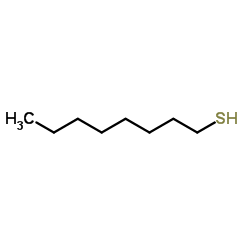1-Mercaptooctane

1-Mercaptooctane structure
|
Common Name | 1-Mercaptooctane | ||
|---|---|---|---|---|
| CAS Number | 111-88-6 | Molecular Weight | 146.294 | |
| Density | 0.8±0.1 g/cm3 | Boiling Point | 199.0±3.0 °C at 760 mmHg | |
| Molecular Formula | C8H18S | Melting Point | -49 °C | |
| MSDS | Chinese USA | Flash Point | 68.9±0.0 °C | |
| Symbol |

GHS07 |
Signal Word | Warning | |
|
Surface modification-induced phase transformation of hexagonal close-packed gold square sheets.
Nat. Commun. 6 , 6571, (2015) Conventionally, the phase transformation of inorganic nanocrystals is realized under extreme conditions (for example, high temperature or high pressure). Here we report the complete phase transformation of Au square sheets (AuSSs) from hexagonal close-packed ... |
|
|
Biodegradation of malodorous thiols by a Brevibacillus sp. strain isolated from a Tunisian phosphate factory.
FEMS Microbiol. Lett. 362 , (2015) Hydrogen sulfide (H2S) and thiols (RSH) generated by the phosphate industry cause harmful effects on human health and quality of life. The present study aims to investigate and evaluate a bacterial strain CAT37 isolated from gas-washing wastewaters in terms o... |
|
|
Open tubular capillary electrochromatography using capillaries coated with films of alkanethiol-self-assembled gold nanoparticle layers.
J. Chromatogr. A. 1083(1-2) , 205-14, (2005) We have used alkanethiol self-assembly and dithiol layer-by-layer (LBL) self-assembly processes to prepare an Au nanoparticle (NP)-coated open tubular capillary electrochromatography (OTCEC) column for the separation of three neutral steroid drugs (testostero... |
|
|
Preparation of porous polymer monoliths featuring enhanced surface coverage with gold nanoparticles.
J. Chromatogr. A. 1261 , 121-8, (2012) A new approach to the preparation of porous polymer monoliths with enhanced coverage of pore surface with gold nanoparticles has been developed. First, a generic poly(glycidyl methacrylate-co-ethylene dimethacrylate) monolith was reacted with cystamine follow... |
|
|
Integration of CdSe/CdSexTe1-x Type-II Heterojunction Nanorods into Hierarchically Porous TiO2 Electrode for Efficient Solar Energy Conversion.
Sci. Rep. 5 , 17472, (2015) Semiconductor sensitized solar cells, a promising candidate for next-generation photovoltaics, have seen notable progress using 0-D quantum dots as light harvesting materials. Integration of higher-dimensional nanostructures and their multi-composition varian... |
|
|
Investigation of the sunscreen octocrylene's interaction with amino acid analogs in the presence of UV radiation.
Photochem. Photobiol. 88(4) , 904-12, (2012) Octocrylene is an organic UV filter, commonly used in sunscreens and cosmetics, which can give rise to both contact and photocontact allergy. Our aim was to investigate octocrylene's interaction with amino acid analogs in the presence of UV radiation to bette... |
|
|
Comprehensive bioimaging with fluorinated nanoparticles using breathable liquids.
Nat. Commun. 6 , 5998, (2015) Fluorocarbons are lipophobic and non-polar molecules that exhibit remarkable biocompatibility, with applications in liquid ventilation and synthetic blood. The unique properties of these compounds have also enabled mass spectrometry imaging of tissues where t... |
|
|
Patterned Plasmonic Nanoparticle Arrays for Microfluidic and Multiplexed Biological Assays.
Anal. Chem. 87 , 11407-14, (2015) For applications ranging from medical diagnostics and drug screening to chemical and biological warfare detection, inexpensive, rapid-readout, portable devices are required. Localized surface plasmon resonance (LSPR) technologies show substantial promise towa... |
|
|
"Size-Independent" Single-Electron Tunneling.
J. Phys. Chem. Lett. 6 , 4986-90, (2015) Incorporating single-electron tunneling (SET) of metallic nanoparticles (NPs) into modern electronic devices offers great promise to enable new properties; however, it is technically very challenging due to the necessity to integrate ultrasmall (<10 nm) parti... |
|
|
Nanostructured SERS-electrochemical biosensors for testing of anticancer drug interactions with DNA.
Biosens. Bioelectron. 80 , 257-64, (2016) Widely used anti-cancer treatments involving chemotherapeutic drugs result in cancer cell damage due to their strong interaction with DNA. In this work, we have developed laboratory biosensors for screening chemotherapeutic drugs and to aid in the assessment ... |